



ISSUE26 Presented by: Published by: Sponsored by:
LEGAL MEDICO MAGAZINE
Built-in radiology viewer
Access and annotate all radiology formats
Secure & Compliant
Industry-Leading security and GDPR compliant
Book a demo
For

Access anywhere
Work whenever, wherever and whatever device suits you
Simplicity
Everything you need in one easy to use workplace
Collaborate
Securely access, share and receive case files
Increased productivity
Simplified & Automated tasks mean less time spent on admin
hello@ALLDOQ.com
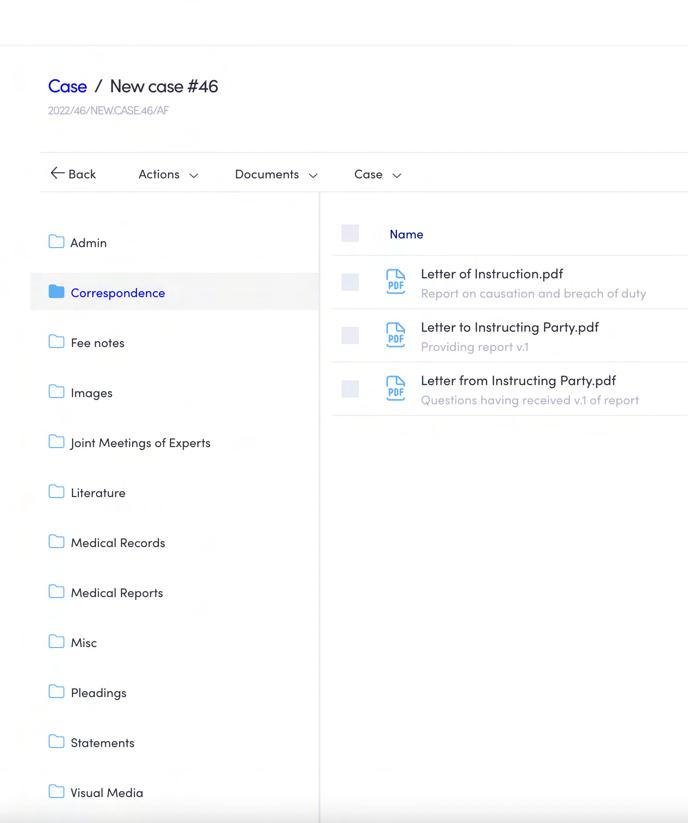

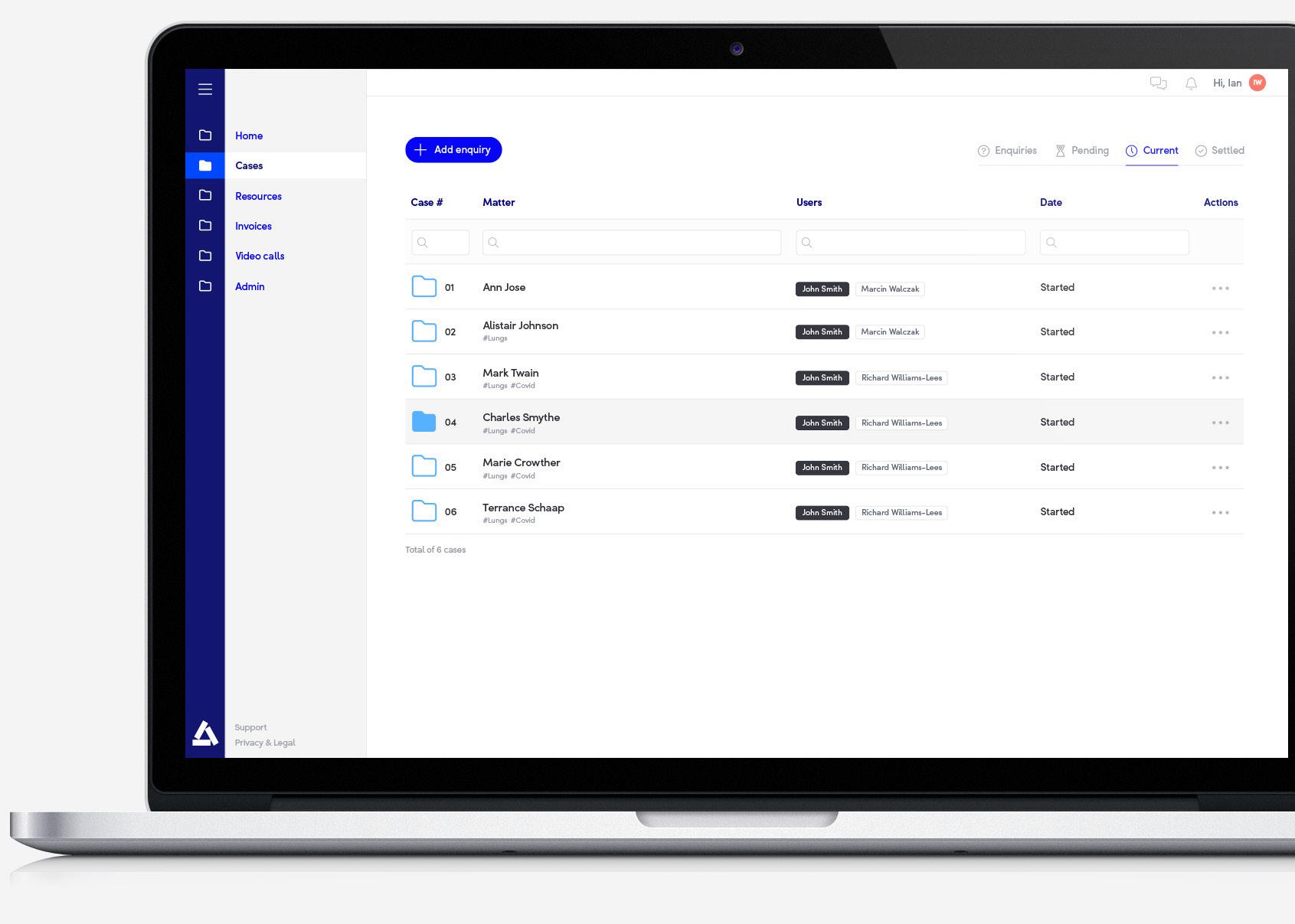

more information or to book a demo visit
ALLDOQ.com
www.
or e-mail
Dashboard

Welcome to the Medico-Legal Magazine
Welcome to Issue 26 of the Medico-Legal Magazine, produced by SpecialistInfo and publishing partner Iconic Media Solutions Ltd.
This summer issue of 2024 coincides with the SpecialistInfo Medico-legal Conference, and all delegates will receive a printed copy.
In our Expert Witness Directory we showcase more featured experts, who are available for instruction now. The following articles are in this issue:
Jennifer Harris, Capsticks Legal Director and speaker at the Conference summarises the recent Supreme Court decisions involving secondary victim claims; and Mr Amar Alwitry, Consultant Ophthalmologist, expert witness and speaker at the Conference, opines on informed consent and how this might affect medical professionals.
Dr Sabira Hughes, Medicolegal Consultant at Medical Protection, presents a case report involving anaesthetic awareness; and finally


Dr Michael D Spencer, Consultant Psychiatrist, Expert Witness and speaker at the Conference, discusses the complex interaction between PTSD, chronic pain, and personal injury litigation.
Once again, the magazine will be circulated to up to 40,000 people in the industry, including doctors, insurance companies, law firms and medico-legal agencies. It has a dedicated website www.medicolegalmagazine.co.uk and a page on the Medico-Legal Section of the Specialistinfo.com website, , where all the back issues can be viewed. Printed copies can be ordered from Iconic Media.
Specialistinfo maintains a database of contact details for up to 90,000 UK consultants and GPs, including approximately 11,000 consultants and GPs who undertake medico-legal work. We also provide Medico-Legal courses for expert witnesses and promote the members of the Faculty of Expert Witnesses (the FEW).
We welcome feedback from our readers, so please contact us with any suggestions for areas you would like to see covered in future issues or share your news and experiences with us.
Lisa Cheyne Specialistinfo
Medico-Legal Magazine
Contents:
SpecialistInfo Medico-Legal Courses 2024 By Lisa Cheyne
Secondary Victim Claims After The Supreme Court Decisions In Paul, Polmear And Purchase By Jennifer Harris 04 14 19 05 23 25 29 11
“Just Sign Here” – Thoughts on Consent in the Post-Montgomery Era By Mr Amar Alwitry
A Case Report From The Medical Protection Files, Discussing How An Anaesthetic Error During Breast Surgery Resulted In A Clinical Negligence Claim For Psychiatric Injury By Dr Sabira Hughes
The Intersection of PTSD, Chronic Pain, and Personal Injury: Navigating the Complexities of Treatment and Litigation By Dr Michael D Spencer MA
Book Review - Clinical Negligence Sixth Edition 2023 By Mikaler Cutts
Expert Witness Directory
Medico-Legal News By Lisa Cheyne
Presented by:

SpecialistInfo t: +44 (0)1423 727 721 e: magazine@specialistinfo.com www.specialistinfo.com
Published by:

Iconic Media Solutions t: +44 (0) 20 3693 1940 e: info@iconicmediasolutions.co.uk www.iconicmediasolutions.co.uk
Medico-Legal Magazine is published by Iconic Media Solutions Ltd. Whilst every care has been taken in compiling this publication, and the statements contained herein are believed to be correct, the publishers do not accept any liability or responsibility for inaccuracies or omissions. Reproduction of any part of this publication is strictly forbidden. We do not endorse, nor is Iconic Media Solutions Ltd, nor SpecialistInfo affiliated with any company or organisation listed within.

3 LEGAL MEDICO MAGAZINE Sponsored by:
MEDICO-LEGAL COURSES
MEDICO-LEGAL COURSES
MEDICO-LEGAL COURSES
S p e c i a l i s t I n f o h a s b e e n p r o v i d i n g h i g h l
S

a c c l a i m e d C P D a c c r e d i t e d M e d i c o - L e g a l C o u r s e s
S p e c i a l i s t I n f o h a s b e e n p r o v i d i n g h i g h l y
I n 1 7 y e a r s w e h a v e
f o r d o c t o r s s i n c e 2 0 0 7 . I n 1 7 y e a r s w e h a v e
a c c l a i m e d C P D a c c r e d i t e d M e d i c o - L e g a l C o u r s e s
t r a i n e d o v e r 2 , 5 0 0 m e d i c a l p r o f e s s i o n a l s .
U P C O M I N G
U P C O M I N G
t r a i n e d o v e r 2 , 5 0 0 m e d i c a l p r o f e s s i o n a l s .
f o r d o c t o r s s i n c e 2 0 0 7 . I n 1 7 y e a r s w e h a v e
t r a i n e d o v e r 2 , 5 0 0 m e d i c a l p r o f e s s i o n a l s .
O u r t u t o r s a r e l e a d i n g p r a c t i s i n g B a r r i s t e r s ,
O u r t u t o r s a r e l e a d i n g p r a c t i s i n g B a r r i s t e r s ,
M e d i a t o r s & P e r s o n a l I n j u r y S o l i c i t o r s . W e
M e d i a t o r s & P e r s o n a l I n j u r y S o l i c i t o r s . W e
O u r t u t o r s a r e l e a d i n g p r a c t i s i n g B a r r i s t e r s ,
w o r k c l o s e l y w i t h t h e m t o d e v e l o p o u r c o u r s e
w o r k c l o s e l y w i t h t h e m t o d e v e l o p o u r c o u r s e
M e d i a t o r s & P e r s o n a l I n j u r y S o l i c i t o r s . W e
p r o g r a m m e a n d t o b u i l d o u r p a n e l o f e x p e r t s
p r o g r a m m e a n d t o b u i l d o u r p a n e l o f e x p e r t s
w o r k c l o s e l y w i t h t h e m t o d e v e l o p o u r c o u r s e
( T h e F a c u l t y o f E x p e r t W i t n e s s e s – T h e F E W )
p r o g r a m m e a n d t o b u i l d o u r p a n e l o f e x p e r t s
( T h e F a c u l t y o f E x p e r t W i t n e s s e s – T h e F E W )
( T h e F a c u l t y o f E x p e r t W i t n e s s e s – T h e F E W )
J o n a t h a n D i n g l e – B a r r i s t e r a n d S p e c i a l i s t
J o n a t h a n D i n g l e – B a r r i s t e r a n d S p e c i a l i s t
P e r s o n a l I n j u r y & C l i n i c a l N e g l i g e n c e M e d i a t o r
P e r s o n a l I n j u r y & C l i n i c a l N e g l i g e n c e M e d i a t o r
J o n a t h a n D i n g l e – B a r r i s t e r a n d S p e c i a l i s t
( H e a d o f C h a m b e r s a t N o r m a n t o n C h a m b e r s )
( H e a d o f C h a m b e r s a t N o r m a n t o n C h a m b e r s )
P e r s o n a l I n j u r y & C l i n i c a l N e g l i g e n c e M e d i a t o r
A n d r e a B a r n e s - S p e c i a l i s t P e r s o n a l I n j u r y &
( H e a d o f C h a m b e r s a t N o r m a n t o n C h a m b e r s )
A n d r e a B a r n e s - S p e c i a l i s t P e r s o n a l I n j u r y &
C l i n i c a l N e g l i g e n c e M e d i a t o r ( N o r m a n t o n
A n d r e a B a r n e s - S p e c i a l i s t P e r s o n a l I n j u r y &
C l i n i c a l N e g l i g e n c e M e d i a t o r ( N o r m a n t o n
C h a m b e r s )
C h a m b e r s )
C l i n i c a l N e g l i g e n c e M e d i a t o r ( N o r m a n t o n
P r o f e s s o r D e r e k A u c h i e – A c a d e m i c , T r i b u n a l
P r o f e s s o r D e r e k A u c h i e – A c a d e m i c , T r i b u n a l
C h a m b e r s )
J u d g e , A r b i t r a t o r a n d M e d i a t o r
J u d g e , A r b i t r a t o r a n d M e d i a t o r
P r o f e s s o r D e r e k A u c h i e – A c a d e m i c , T r i b u n a l
J u d g e , A r b i t r a t o r a n d M e d i a t o r
P l e a s e b e a w a r e : R u l e s f o r e x p e r t e v i d e n c e h a v e c h a n g e d
P l e a s e b e a w a r e : R u l e s f o r e x p e r t e v i d e n c e h a v e c h a n g e d
s i n c e 2 0 2 0 a n d i t i s r e c o m m e n d e d t h a t a l l e x p e r t s b o o k a n
s i n c e 2 0 2 0 a n d i t i s r e c o m m e n d e d t h a t a l l e x p e r t s b o o k a n
u p d a t i n g s e s s i o n t o e n s u r e t h e y a r e c o m p l i a n t .
P l e a s e b e a w a r e : R u l e s f o r e x p e r t e v i d e n c e h a v e c h a n g e d
s i n c e 2 0 2 0 a n d i t i s r e c o m m e n d e d t h a t a l l e x p e r t s b o o k a n
u p d a t i n g s e s s i o n t o e n s u r e t h e y a r e c o m p l i a n t .
u p d a t i n g s e s s i o n t o e n s u r e t h e y a r e c o m p l i a n t .
T o b o o k y o u r p l a c e , u s e t h e Q R c o d e o r v i s i t
T o b o o k y o u r p l a c e , u s e t h e Q R c o d e o r v i s i t
w w w . s p e c i a l i s t i n f o . c o m / c o u r s e - c a l e n d a r
w w w . s p e c i a l i s t i n f o . c o m / c o u r s e - c a l e n d a r
T o b o o k y o u r p l a c e , u s e t h e Q R c o d e o r v i s i t
o r y o u c a n e m a i l l i s a @ s p e c i a l i s t i n f o . c o m
w w w . s p e c i a l i s t i n f o . c o m / c o u r s e - c a l e n d a r
o r y o u c a n e m a i l l i s a @ s p e c i a l i s t i n f o . c o m
o r c a l l u s o n 0 1 4 2 3 7 8 7 9 8 4
o r c a l l u s o n 0 1 4 2 3 7 8 7 9 8 4
o r y o u c a n e m a i l l i s a @ s p e c i a l i s t i n f o . c o m
o r c a l l u s o n 0 1 4 2 3 7 8 7 9 8 4
BOOK YOUR PLACE TODAY Scan the QR code to see our 2024 Course Calendar
YOUR PLACE TODAY Scan the QR code to see our 2024 Course Calendar
C O U R S E S
U P C O M I N G
C O U R S E S
C O U R S E S
P E R S O N A L I N J U R Y
P E R S O N A L I N J U R Y
P E R S O N A L I N J U R Y
£ 3 9 5 + v a t 2 1 8 S t r a n d , L o n d o n
£ 3 9 5 + v a t 2 1 8 S t r a n d , L o n d o n
£ 3 6 0 + v a t v i r t u a l c l a s s r o o m
C L I N I C A L N E G L I G E N C E T u e s d a y 9 t h J u l y
C L I N I C A L N E G L I G E N C E T u e s d a y 9 t h J u l y
£ 3 9 5 + v a t 2 1 8 S t r a n d , L o n d o n
£ 3 6 0 + v a t v i r t u a l c l a s s r o o m
£ 3 6 0 + v a t v i r t u a l c l a s s r o o m
W e d n e s d a y 1 0 t h J u l y
C L I N I C A L N E G L I G E N C E T u e s d a y 9 t h J u l y
W e d n e s d a y 1 0 t h J u l y
£ 3 9 5 + v a t 2 1 8 S t r a n d , L o n d o n
W e d n e s d a y 1 0 t h J u l y
£ 3 9 5 + v a t 2 1 8 S t r a n d , L o n d o n
£ 3 6 0 + v a t v i r t u a l c l a s s r o o m
£ 3 9 5 + v a t 2 1 8 S t r a n d , L o n d o n
£ 3 6 0 + v a t v i r t u a l c l a s s r o o m
£ 3 6 0 + v a t v i r t u a l c l a s s r o o m
E X P E R T R E A C C R E D I T A T I O N
E X P E R T R E A C C R E D I T A T I O N
W e d n e s d a y 1 1 t h S e p t e m b e r
E X P E R T R E A C C R E D I T A T I O N
W e d n e s d a y 1 1 t h S e p t e m b e r
£ 3 9 5 + v a t 2 1 8 S t r a n d , L o n d o n
W e d n e s d a y 1 1 t h S e p t e m b e r
£ 3 9 5 + v a t 2 1 8 S t r a n d , L o n d o n
£ 3 6 0 + v a t v i r t u a l c l a s s r o o m
£ 3 9 5 + v a t 2 1 8 S t r a n d , L o n d o n
£ 3 6 0 + v a t v i r t u a l c l a s s r o o m
£ 3 6 0 + v a t v i r t u a l c l a s s r o o m
P E R S O N A L I N J U R Y
P E R S O N A L I N J U R Y
T h u r s d a y 3 r d O c t o b e r
P E R S O N A L I N J U R Y
T h u r s d a y 3 r d O c t o b e r
£ 3 9 5 + v a t 2 1 8 S t r a n d , L o n d o n
£ 3 9 5 + v a t 2 1 8 S t r a n d , L o n d o n
T h u r s d a y 3 r d O c t o b e r
£ 3 6 0 + v a t v i r t u a l c l a s s r o o m
£ 3 9 5 + v a t 2 1 8 S t r a n d , L o n d o n
£ 3 6 0 + v a t v i r t u a l c l a s s r o o m
£ 3 6 0 + v a t v i r t u a l c l a s s r o o m
C L I N I C A L N E G L I G E N C E
C L I N I C A L N E G L I G E N C E
F r i d a y 4 t h O c t o b e r
C L I N I C A L N E G L I G E N C E
F r i d a y 4 t h O c t o b e r
£ 3 9 5 + v a t 2 1 8 S t r a n d , L o n d o n
YOUR PLACE TODAY Scan the QR code to see our 2024 Course Calendar T h u r s d a y 1 7 t h O c t o b
£ 3 9 5 + v a t 2 1 8 S t r a n d , L o n d o n
F r i d a y 4 t h O c t o b e r
£ 3 6 0 + v a t v i r t u a l c l a s s r o o m
£ 3 9 5 + v a t 2 1 8 S t r a n d , L o n d o n
£ 3 6 0 + v a t v i r t u a l c l a s s r o o m
£ 3 6 0 + v a t v i r t u a l c l a s s r o o m
T h u r s d a y 1 7 t h O c t o b e r
h u r s d a y 1 7 t h O c t o b e r £ 4 4 0 + v a t 2 1 8 S t r a n d , L o n d o n
£ 4 4 0 + v a t 2 1 8 S t r a n d , L o n d o n
3 9 5 + v a t v i r t u a l c l a s s r o o m
£ 3 9 5 + v a t v i r t u a l c l a s s r o o m C O U R T R O O M S K I L L S
O U R T R O O M S K I L L S T u e s d a y 1 2 t h N o v e
T u e s d a y 1 2 t h N o v e m b e r
£ 1 8 0 + v a t v i r t u a l c l a s s r o o m M E D I C O - L E G A L S E C R E T A R Y O N L I N E C O U R S E

4 LEGAL MEDICO MAGAZINE Sponsored by:
r £ 4 4 0 + v a t 2 1 8 S t r a n d
o
o n £
C
L L S T u e s d a
1 2 t h N o v e m b e r £ 1 8 0 + v a t v
u a l c l a s s
o
m M E D I C O
L E G A L S E C R E T A R Y O N L I N E C O U R S E
BOOK
e
, L
n d
3 9 5 + v a t v i r t u a l c l a s s r o o m
O U R T R O O M S K I
y
i r t
r
o
-
y a c c l a i m e d C P D a c c r e d i t e d M e d i c o - L e g a l C o u r s e s
o
e 2 0 0 7 .
f
r d o c t o r s s i n c
m b e r £ 1 8 0 + v a t v i r t u a l c l a s s r o o m M E D I C O - L E G A L S E C R E T A R Y O N L I N E C O
R
T
£
C
U
S E
p e c i a l i s t I n f o h a s b e e n p r o v i d i n g h i g h l y
BOOK

– THOUGHTS ON CONSENT IN THE POST-MONTGOMERY ERA
By Mr Amar Alwitry, Consultant Ophthalmologist, Alwitry Medicolegal Services alwitrymedlegalpa@btinternet.com
Mr Alwitry is a Consultant Ophthalmologist working in the East Midlands and is a speaker at the 2024 Medico-Legal Conference. He has a Masters in Medical Law and is a Speciality Advisor to the CQC. He has an active interest in teaching and training in Medico-legal issues, delivering lectures around the country on patient safety, learning and consent. He is also author of "Complaints, Litigation and Clinical Errors" published by Taylor and Francis, a book for all medical and allied professionals.
The Consent process is a vital part of the patient pathway and is far more than just getting the patient to sign on the dotted line. In my work in litigation, I often see issues around informed consent resulting in complaints and potential clinical negligence claims. Anecdotally I can see an increasing number of these cases.
We have a duty of care to the patient to engage with them and we need to undertake our work in partnership with them. We undertake a lot

5 LEGAL MEDICO MAGAZINE Sponsored by:
SIGN
“JUST
HERE”
of operations every year and the vast majority are carried out without complications. A lot of our work is standard and straight forward and therefore when things go wrong patients inevitably ask the question as to why it happened.
From my speciality cataract surgery, one of the most common operations, is arguably one of the safest procedures carried out within the NHS. Everyone gets cataracts to some degree and when you reach a certain age you will inevitably have some degree of lens opacity. The operation is only about 20 minutes long and the visual recovery is almost immediate. Often patients are in hospital only for a few hours and go home the same day. They know people who have had cataract surgery, and everything was fine. They may have had their first eye done and everything was fine. So, when things go wrong, and they lose vision they seek to apportion blame.
It is often hard to opine on surgery and surgical complications. If things go wrong such as a clip falling off a bile duct during cholecystectomy is that a breach of duty? Naturally these complications will be consented for, but patients cannot consent for negligent treatment.
When things go well patients do not complain and in the vast majority of cases this is the case, but we all are painfully aware that sometimes things can and do go wrong.
I liken the surgery to a bridge we guide the patient over. There is a chasm beneath with some stormy waters they could fall into. We take them from the proximal side of health issue and aim to take them over to the other side where there is resolution of their issue. The vast majority get over it without a problem, but it does not take away from the necessity to fully inform the patient of the dangers involved. If everything goes well does it matter? Well yes it does. Turning up for the surgery does not mean that they are willing to take any risk.
If I were on an adventure outing and crossed the bridge mentioned above only to be told afterwards
that 1 in 100 people who did so fell and lost their lives I would not be happy. Even having already crossed it safely I would be aggrieved at the loss of choice. I turned up for the trip but did not want to take such a risk without my prior consent. I would have rather stayed on this side of the chasm. Patients need to enter the process with open eyes (pun intended from an ophthalmologist perspective).
Whatever our attitudes to consent were, the pivotal Montgomery case in 20151 was a landmark for informed consent in the UK and significantly changed the playing field for us as clinicians.
Montgomery vs Lanarkshire had nothing to do with eyes but the implications of it are important for all specialities. It involved the case of Nadine Montgomery, a woman with diabetes and of small stature. She was pregnant and delivered her son vaginally. He sadly experienced complications owing to shoulder dystocia resulting in hypoxic brain damage with consequent cerebral palsy. Mrs Montgomery brought a claim against Lanarkshire Health Board, alleging that she should have been advised of the 9-10% risk of shoulder dystocia associated with vaginal delivery notwithstanding the risk of a grave outcome was small (less than 0.1% risk of cerebral palsy).
The case and judgment centres around the fact that her obstetrician had not disclosed the increased risk of this complication in vaginal delivery, despite the mother specifically asking if the baby’s size was a potential problem. Montgomery sued for negligence, arguing that, if she had known of the increased risk, she would have requested a caesarean section. She was effectively deprived of choice.
The Supreme Court found in her favour in March 2015. It established that, rather than being a matter for clinical judgment to be assessed by professional medical opinion, a patient should be told whatever they want to know, not what the doctor thinks they should be told.
The final judgment should be read and absorbed by us all:

6 LEGAL MEDICO MAGAZINE Sponsored by:

'An adult person of sound mind is entitled to decide which, if any, of the available forms of treatment to undergo, and her consent must be obtained before treatment interfering with her bodily integrity is undertaken.
'The doctor is therefore under a duty to take reasonable care to ensure that the patient is aware of any material risks involved in any recommended treatment, and of any reasonable alternative or variant treatments.
'The test of materiality is whether, in the circumstances of the particular case, a reasonable person in the patient's position would be likely to attach significance to the risk, or the doctor is or should reasonably be aware that the particular patient would be likely to attach significance to it.' It was a clear boost for patient autonomy over medical paternalism and frankly I was amazed that it made it into Court. It seems like a “no-brainer” and what we should have been doing anyway.
Clearly, we have now moved from the ‘reasonable doctor’ to the ‘reasonable patient’ test as the marker for consent and rightly so.
From a legal perspective, prior to Montgomery, the Bolam test 2 in England was used to determine what should be disclosed. This tested whether a doctor’s conduct would be supported by a responsible body of clinicians. So, previously if a responsible body of clinicians felt that the amount of information provided was reasonable and what they would have done, it was acceptable in law.
In Ophthalmology we are fortunate in that we are rarely in an emergency situation which requires rapid consent. Most of the time we operate electively and patients have time to consider their options and the risk involved.
We are however challenged by the delicate and specific nature of the eye and eye anatomy. Patients understand the concepts of broken bones, gall stones and complications such as deep vein thrombosis, infection and scars. They understand that they can bleed from an abdominal procedure and that in cancer procedures sometimes it is impossible to clear away the disease but what do they understand by the term posterior capsule rupture? Do they truly understand what it is all about and how do we educate them to give them true informed consent without teaching them and testing them on the anatomy of the eye?
We also have an elderly population who may not understand everything we tell them. And there lies the rub of generalisation and paternalism in our profession. We should move away from the classification of elderly and really assess the individual patient and their level of understanding and need to understand.
Despite my best efforts to consent patients and my explanation about “the clear cellophane type bag around the lens that can sometimes rupture and allow the jelly at the back to come forward or even worse allow the lens to fall to the back” and what I consider a great explanation about how I “break the lens up with ultrasound and suck it

7 LEGAL MEDICO MAGAZINE Sponsored by:
out with a vacuum” I still get patients on the table asking “what are you actually doing” and “Oh, I thought it was just a membrane you peeled away”. We have a duty to educate patients and inform them about what we are going to do and what the possible complications are. Furthermore, it is vital that we engage with the patient on their level. Many of the patients I see are less young and we do need to make a judgment on how much they will comprehend but that should be an active judgment based on the individual patient, their needs, their understanding and their particular circumstances. It is an active process and not a passive one.
The concept of empowering autonomy has a contradiction when patients do not want to know the risks of surgery. In my speciality eyes and vision are emotive and a cause for anxiety.
One prospective survey study by Tan and colleagues 3 investigated 100 patients’ preferences for information and discussion prior to routine cataract surgery. Of the entire group of 100, 32 did not wish to know "anything at all" about risks and would prefer to leave decision making to their ophthalmologist; 22 were interested only in knowing their overall chance of visual improvement; and 46 welcomed a general discussion of possible complications, of whom 25 went on to enquire about specific complications.
In the era of informed consent and respecting patient autonomy should we be forcing the third of patients who do not wish to know “anything at all” about the risks to listen to us as we relay what could go wrong but probably wouldn’t? The answer is yes naturally but who are we protecting, the patient or ourselves? Are we writing things on the consent form purely to point to it later if things do go wrong or are we truly engaging in the process and ethos of consent? Sadly, I see a bit of both occurring regularly.
I often get told by the patient that they do not want to know the risks and trust me, a position and responsibility which continues to humble me. I do
operating lists of ten cataract patients, and I am still awed that they trust me with their sight and ten people wake up next day to new vision.
If they do not want to know the risks is that such a bad thing? When I get on an aeroplane, I am putting my life and safety in the hands of the pilot and the airline. Do I question how many times they have flown or what their safety track record is? Do I ask to assess the maintenance logs for the plane or do I trust that all the safety checks have been done and they will keep me as safe as they can?
Clearly healthcare is different to flying on a plane and we need to do everything we possibly can to engage with patients and ensure they are making informed decisions about their care. We do not have time, and there are barriers in place, but we need to make time. More and more we will face patients asserting they were not told of risks and so we, as a medical profession, need to safeguard ourselves by documenting what patients are told (handing an information sheet to a patient or getting them to sign a form is not good enough) and more importantly ensure that they understand what we are telling them.
Consent will continue to evolve and we need to evolve with it. The patient has to come first.
References:
[1] Montgomery v Lanarkshire Health Board [2015] UKSC 11.
[2] Bolam v Friern Hospital Management Committee (1957) 1 WLR 582.
[3] Tan LT, Jenkins H, Roberts-Harry J, Austin M. Should patients set the agenda for informed consent? A prospective survey of desire for information and discussion prior to routine cataract surgery. Ther Clin Risk Manag. 2008 Oct;4(5):1119-25.

8 LEGAL MEDICO MAGAZINE Sponsored by:

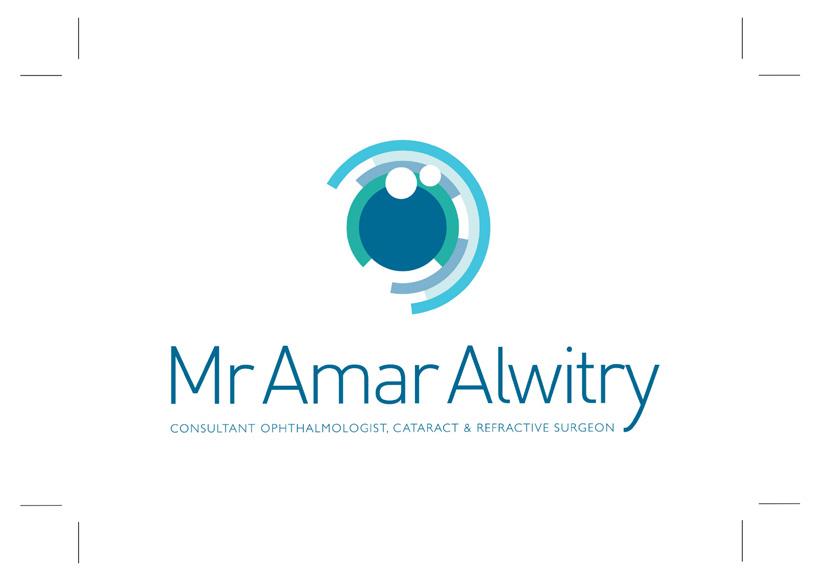
www.amaralwitry.com
Specialising in the delivery of independent, evidence based Expert Witness Reports .
Care, Aids and Equipment
Liability, Breach of Duty and
Screening/Short Form Reports
Immediate
Needs Assessments
Loss of Service Reports
Coroner Reports
Whether you require a Care, Aids and Equipment report, Liability report or Immediate Needs Assessment, our highly qualified, clinical associates are on hand across the UK to provide their specialist expert opinion. We have experts in the majority of disciplines, including but not limited to:
Brain Injury
Industrial Disease
Cerebral Palsy
Birth Injury
Amputations
Mental Health
Orthopaedic Injury
Spinal injury
Our reputation for delivering, timely, high-quality reports, is why our clients instruct us again and again, safe in the knowledge they will receive an independent, comprehensive and objective report.
tessagough.co.uk
info@tessagough.co.uk 020 7435 9247
Tessa Gough Associates
Visit our stand at the Medico-Legal conference and say hello to our Senior Associate, Natalie Fraser, to learn more about TG Associates.

10 LEGAL MEDICO MAGAZINE Sponsored by:

A CASE REPORT FROM THE MEDICAL PROTECTION FILES, DISCUSSING HOW AN ANAESTHETIC ERROR DURING BREAST SURGERY RESULTED IN A CLINICAL NEGLIGENCE CLAIM FOR PSYCHIATRIC INJURY
By Dr Sabira Hughes, Medicolegal Consultant, Medical Protection
A 41-year-old project manager, Mrs F, underwent breast uplift surgery, performed on a private basis.
Induction of anaesthesia was performed by Dr T using propofol and fentanyl, and a laryngeal mask airway was inserted. A muscle relaxant was also administered. Anaesthesia was maintained with a propofol infusion, and a remifentanil infusion was also used.
Shortly after Mrs F had been transferred from the anaesthetic room to theatre, her heart rate significantly increased, as did her blood pressure. This change was recorded on the anaesthetic monitoring printout, but not recorded in the handwritten anaesthetic chart.
Dr T interpreted the increase in heart rate and blood pressure as indicative of the level of anaesthesia as being light. He increased the rate of infusion of both

11 LEGAL MEDICO MAGAZINE Sponsored by:
propofol and remifentanil and gave midazolam. Dr T did not record on the anaesthetic chart why these measures had been taken.
The surgery proceeded uneventfully, but on recovering from anaesthesia, Mrs F stated to ward staff that she had “woken up” during the operation, had heard the surgeon talking and had felt tugging and pushing. She tried to scream and move away but could not.
Mrs F brought a claim against Dr T for intraoperative accidental awareness resulting in psychiatric injury.
Dr T contacted Medical Protection, who instructed a consultant anaesthetist to provide an expert report.
The expert was supportive of the decision by Dr T to give midazolam and to increase the rate of infusion of propofol and remifentanil when Mrs F’s heart rate and blood pressure increased, and anaesthesia was suspected to be light.
However, the expert identified four clinical concerns regarding Dr T’s care:
1. that a target-controlled infusion pump (which would have used mathematical modelling to calculate and adjust the dose) was not used;
2. there had been a failure to perform any calculation or refer to an infusion regime about the rate of propofol infusion that would be required to keep Mrs F adequately anaesthetised;
3. there was no surgical or anaesthetic requirement for muscle relaxation to be used in this particular case, and the use of a muscle relaxant contributed to the occurrence of awareness, as did the failure to monitor the depth of anaesthesia (although such monitoring would not be mandatory); and
4. there was a failure to clearly document the changes on the anaesthetic chart.
Medical Protection met with Dr T and held a detailed discussion about the medical records, the expert opinion, Dr T’s own views on the case, and options on strategy. Dr T consented for Medical Protection to resolve the claim on best terms, and Medical Protection achieved a swift settlement of the claim for a low sum to reflect Mrs F’s psychiatric injury.
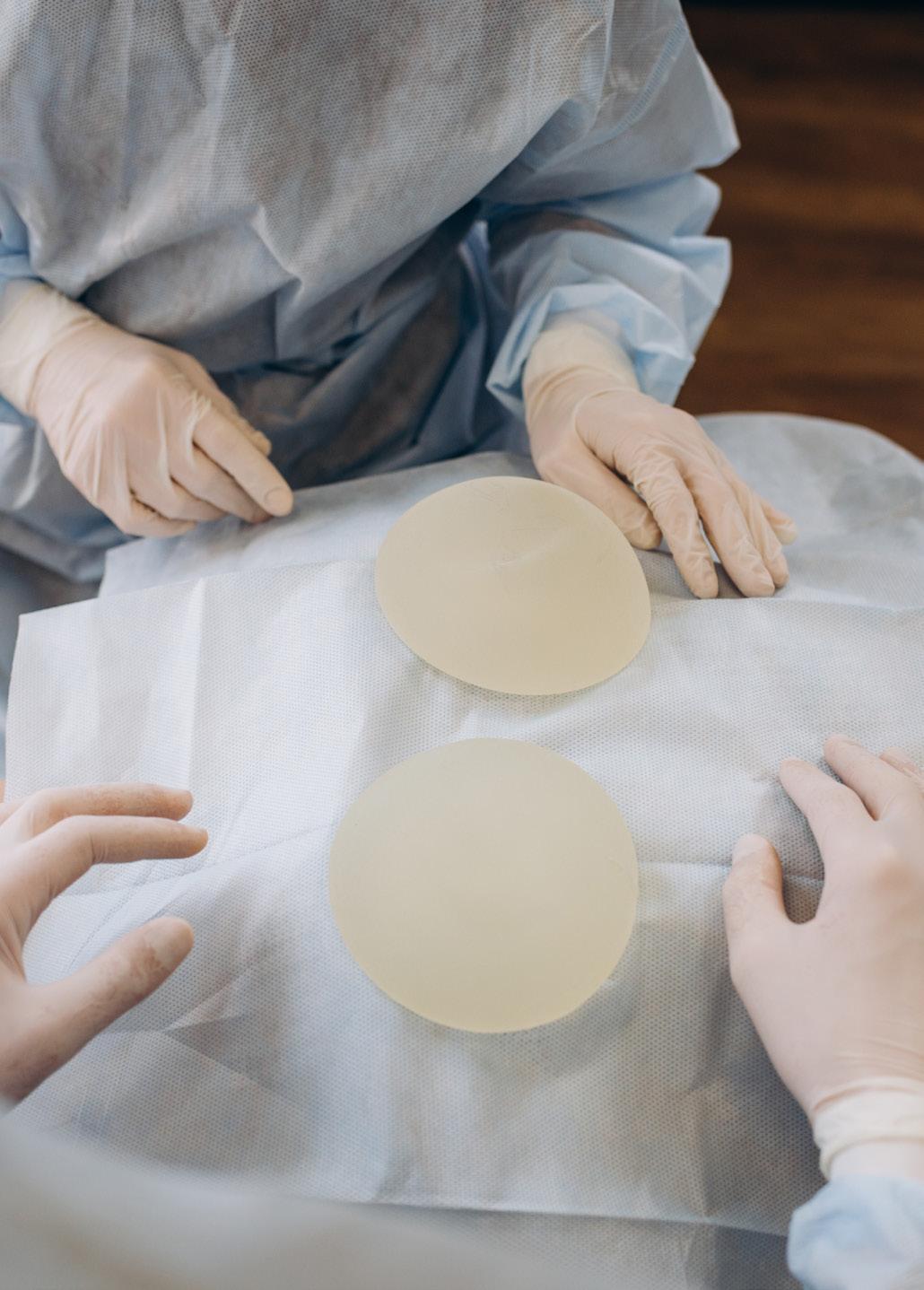
Learning points
• If a target-controlled infusion pump is not used to administer total intravenous anaesthesia, then careful consideration and calculation of the rate to be infused must be performed. A number of infusion regimes have been described for use when manually adjusting infusion rates of propofol.
• The risk of anaesthetic awareness is increased when a patient is paralysed, and thought should be given on whether use of a muscle relaxant is necessary for the particular procedure being performed.
• Consider using a depth of anaesthesia monitor when administering total intravenous anaesthesia, especially when a muscle relaxant is also administered.
• Contemporaneous record keeping should be accurate and reflect the events that have occurred.

12 LEGAL MEDICO MAGAZINE Sponsored
by:
Search, instr uct and manage your experts easily th rough our easy to use, s ecure online platform.
Our technolog y takes the hassle out of searching for exp erts, n egotia t ing fees and turn around times, and transmi tti ng documentation, so you can red uce time spent on managing experts, and spend more t ime on what ma tters - managin g the strategy o f the case and d elivering bet ter res ults for your clien t s.

Contact us t od ay: 0203 355 979 6 admin@tmlep.com
w w w . t m lep.com WELCO ME T O THE FUTURE OF INSTRUCTING EXPERT E VIDENCE

THE INTERSECTION OF PTSD, CHRONIC PAIN, AND PERSONAL INJURY: NAVIGATING THE COMPLEXITIES OF TREATMENT AND LITIGATION
By Dr Michael D Spencer MA, MD, MB BChir, FRCPsych
Consultant Psychiatrist, Cambridgeshire and Peterborough NHS Foundation Trust; Honorary Consultant Psychiatrist, Pain Management Centre, University College London Hospitals NHS Foundation Trust Further information and contact details: mdspencer.com | psychiatry-expert.com
Introduction
The intersection of post-traumatic stress disorder (PTSD), chronic pain, and personal injury presents a complex landscape with significant implications for both medical treatment and the medicolegal process. Understanding how these conditions interact and influence each other is essential for experts to provide accurate and evidence-based advice to the Court in chronic pain cases. This article provides an introduction to the intricate

14 LEGAL MEDICO MAGAZINE Sponsored by:
relationships among these factors, examining how chronic pain and PTSD are intertwined with personal injury litigation and the implications for treatment strategies.
Relevance of the Intersection
Chronic pain and litigation have been cited as risk factors for promoting adverse outcomes in PTSD. Similarly, PTSD and litigation are recognised as factors that can negatively impact the outcomes of treatments for chronic pain conditions, such as neuromodulation (Gatchel et al., 2007).
This raises the question of whether PTSD and/ or chronic pain can improve or respond to treatments during litigation, or whether treatment should be postponed until after a legal settlement is reached. The reality, however, is more nuanced. Chronic pain and PTSD often coexist, creating a bidirectional relationship where each condition can exacerbate the other. PTSD symptoms are common in individuals with chronic pain, with various large studies reporting between 10 – 50% of patients referred for chronic pain rehabilitation as meeting diagnostic criteria for PTSD (Asmundson et al, 2002; Andersen et al, 2012; Andersen et al, 2014). Similar variation in the prevalence of chronic pain symptoms has been reported in individuals with PTSD, with rates between around one-third to two-thirds - although research has largely involved veteran rather than civilian populations (Beckham et al, 1997; Shipherd et al, 2007).
Chronic pain can serve as a constant reminder of the traumatic event, triggering PTSD symptoms and leading to heightened pain sensitivity. Conversely, PTSD-related hyperarousal and anxiety can amplify the perception of pain, creating a vicious cycle of mutual maintenance, that complicates both conditions (Sharp and Harvey, 2001; Asmundson et al., 2002; Jenewein et al, 2009). A number of studies have indicated that the presence of PTSD symptoms has an adverse impact on the course of chronic pain complaints following injury such as whiplash, being associated with a more severe and
persistent pain presentation (Buitenhuis et al, 2006; Sterling et al, 2006); and in turn that more severe pain and disability is correlated with a more persistent course of PTSD symptoms (Ravn et al, 2019; Giummarra et al, 2017).
Figure 1 illustrates the process whereby the mutually maintaining interactions between psychological trauma and chronic pain can promote a cycle of chronic pain, PTSD, and avoidance behaviour, leading to increasing disability and distress.
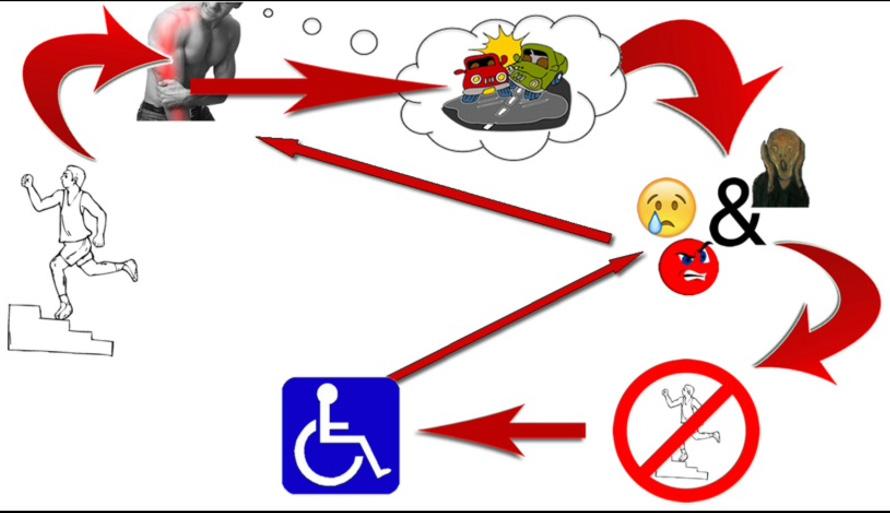
Figure 1 – Mutually maintaining interactions between psychological trauma and chronic pain: Intrusive pain symptoms serve as a persisting reminder of the traumatic event, triggering PTSD symptoms and accompanying distressing emotions, and setting up a pattern of mutual maintenance where avoidance of sensations associated with the trauma leads to escalating levels of disability and distress.
Psychological factors play a crucial role in linking chronic pain and PTSD. Anxiety, hypervigilance, and trauma-focused cognitive processes can amplify pain perception, while maladaptive coping strategies, such as avoidance and catastrophising, can sustain both conditions (Vlaeyen & Linton, 2000). Perceived injustice and catastrophisation have been shown to play important roles in sustaining both PTSD and pain symptoms following physical injuries such as whiplash injury (Sullivan et al, 2011; Sullivan et al, 2012; Andersen et al, 2016). Understanding

15 LEGAL MEDICO MAGAZINE Sponsored by:
these mechanisms is essential for developing effective treatment strategies that address both the psychological and physical aspects of these conditions.
Neurobiological studies suggest that chronic stress and hyperarousal associated with PTSD can alter pain thresholds and pain processing pathways, leading to increased pain sensitivity and chronicity (Defrin et al., 2008). The interplay between the central nervous system's response to pain and stress underscores the importance of integrated treatment approaches that address both PTSD and chronic pain.
Impact of Litigation on PTSD and Chronic Pain
Personal injury litigation introduces additional stressors with the potential to exacerbate both PTSD and chronic pain. The adversarial nature of the legal process, the requirement to repeatedly recount traumatic events, and the uncertainty of legal outcomes can all serve as significant stressors with the potential to exacerbate the symptomatology of these conditions. A sense of not being believed may also represent a stressor – and as Hickling et al (2006) commented, “Patients as participants in this process may come to see that even though they see themselves as the victims, they are now the ones placed on trial, exacerbating their sense of vulnerability and victimization.” However, it is important to recognise that discussing trauma memories is not necessarily “re-traumatising” (Murray et al., 2022). While many individuals may experience distress when talking about their trauma memories, and some might experience a temporary, modest symptom exacerbation afterwards, research in trauma-focused CBT (TF-CBT) suggests that engaging with, rather than avoiding, trauma memories through talking and/or writing is one of the most effective elements of treatment (Shearing et al., 2011).
Involvement in litigation has been associated with elevated distress and slower recovery among patients with PTSD (Blanchard et al., 1998; Frueh et al., 2003), greater levels of pain and disability (Tait et al., 1990),
and poorer outcomes following spinal surgery (Epker and Block, 2001; Harris et al., 2005).
On the other hand, Mayou and colleagues reported that involvement in litigation did not predict any aspect of psychological outcome at one year following a road traffic accident (Mayou et al, 1993), whilst Bryant and Harvey reported that settlement of compensation claims following motor vehicle accidents did not influence reported PTSD symptoms (Bryant and Harvey, 2003). Andersen and colleagues found that patients can still benefit from multidisciplinary chronic pain rehabilitation despite the presence of comorbid PTSD (Anderson et al, 2014).
A systematic review of 29 prospective cohorts of patients with whiplash-associated disorder (WAD) found that litigation was not a predictor of outcome (Scholten-Peeters et al., 2003). More recent studies have indicated that individuals with active litigation can experience improvements in emotional distress, pain intensity and return-to-work status following interdisciplinary pain management programs (Gagnon et al., 2013); furthermore, clinically significant improvements in pain measures have been reported following a UK-based multidisciplinary pain management program, even among individuals involved in litigation (Twiddy et al., 2019).
Thus, whilst the literature points to associations that underscore the potential for litigation to negatively impact both psychological and physical health outcomes, the relationship between litigation and health outcomes is complex and not universally negative; and while litigation can introduce stressors that potentially exacerbate PTSD and chronic pain, effective treatment strategies can still be beneficial.
Additionally, there is evidence suggesting that individuals involved in litigation can still benefit from treatment for PTSD, supporting the notion that litigation should not serve as an exclusion criterion for psychological intervention (Shorer et al., 2021). This perspective aligns with the NICE guidelines on the management of PTSD (National Collaborating Centre for Mental Health, 2005), which recommend that “Healthcare professionals

16 LEGAL MEDICO MAGAZINE Sponsored by:

should not delay or withhold treatment for PTSD because of court proceedings or applications for compensation” – thus emphasising the importance of providing timely and appropriate care to individuals with PTSD, irrespective of their involvement in litigation.
Neuromodulation and Psychological Assessment
In the realm of neuromodulation for chronic pain, there has been a significant shift from viewing psychological assessments as gate-keeping mechanisms designed to exclude patients with “red flags”, to an approach that emphasises the role of the psychologist and/or psychiatrist in supporting the patient and the multidisciplinary team, and contributing to multimodal prehabilitation. This shift recognises the importance of providing treatment at the right time and focuses on improving measurable psychosocial factors - such as “patient activation”, which refers the “ extent to which patients are engaged and active in their own health care ” (Hibbard et al, 2004). Recent research indicates the role of increased patient activation in mediating positive outcomes from spinal surgery, even where adverse psychosocial risk factors are present (Block et al, 2019).
Thus, whilst ongoing litigation has been associated with poorer outcomes following spinal surgery, recent advances in the practice of psychologically-informed prehabilitation, multidisciplinary working and our understanding of how to support patients with psychosocial risk factors such as psychological trauma and ongoing litigation does highlight the need for research to inform guidelines on the management of these complex cases.
Conclusion
The intersection of PTSD, chronic pain, and personal injury litigation presents a complex and challenging landscape for both medical and legal professionals. Understanding the intricate relationships among these factors highlights the intertwined nature of chronic pain and PTSD, and is essential for experts to provide accurate and evidence-based advice to the Court in chronic pain cases.






17 LEGAL MEDICO MAGAZINE Sponsored by: Scan the QR-Code below to view the full list of references 4 th March 2025 | Congress Centre, London Book Your Pass Live or Virtual Join us for the third Medical AI, Robotics and Technology Conference 2025 www.medical-ai-and-robotics.com BOOK PASS


AI P AGI NAT ION AND
Created with input from expert witnesses and lawyers by a leading tech provider in the medico-legal industry this technology brings usability and security to one of the biggest pain points in expert instruction.
Giving access to ISO27001 compliant storage, unlimited transfers and a diagnostic grade radiology viewer getting records and imaging securely between parties has never been easier . With market-leading fixed-fee pricing, reach out today to see how we can solve your records and imaging requirements.
Contact us today:
0203 355 979 6 titanemr @tmlep.com
ww w . tit an -emr .c om
SE CU R E R E CO R DS AND IMA GING S TOR AGE

SECONDARY VICTIM CLAIMS AFTER THE SUPREME COURT DECISIONS IN PAUL, POLMEAR AND PURCHASE
By Jennifer Harris, Legal Director, Capsticks LLP - Jennifer.Harris@capsticks.com
Jennifer is a clinical negligence claims expert specialising in claims of the utmost severity including hypoxic brain damage, spinal nerve injuries and multilimb amputations. Jennifer is also the claims division mediation lead and delivers training to lawyers and senior medical personnel to ensure they understand the importance of the process in rebuilding relationships between patients, their families and the NHS.
The Supreme Court Judgment in Paul and another v Royal Wolverhampton NHS Trust; Polmear and another v Royal Cornwall Hospitals NHS Trust;
and Purchase v Ahmed [2024] UKSC 1 confirms that doctors do not owe a duty of care to patient’s families psychologically impacted by witnessing a relative’s death, injury or decline, even where it may have been negligently caused.
Whilst claims under the Fatal Accidents Act 1976 for bereavement and Law Reform ( Miscellaneous Provisions ) Act 1934 for recoverable dependency (financial and services/care) remain available it appears that, in a clinical negligence setting, secondary victim claims will no longer be viable.

19 LEGAL MEDICO MAGAZINE Sponsored by:
A short history lesson - secondary victim claims and the Alcock criteria
By way of reminder, a primary victim is someone directly injured by the negligent act of another. A secondary victim however is someone who is not directly involved in the incident but witnesses it and either sees the primary victim being injured or fears for the primary victim’s life and suffers psychiatric injury as a result.
The need to manage the scope of secondary victim claims was considered in Alcock v Chief Constable of Yorkshire Police [1992] 1 AC 310 (Alcock) where a number of claims were brought by friends and relations for psychological injury after witnessing loved ones die or suffer injury on TV during the Hillsborough disaster. Those claims failed due to a lack of proximity the claimants being considered too far removed in time and space from events.
This led the Court to set out the following criteria by way of ‘control measures’ clarifying that secondary victim claimants would have to prove that:
1. it was reasonably foreseeable a person of ‘normal fortitude’ would suffer psychiatric injury from witnessing the index event
2. there was a close tie of love and affection to the primary victim
3. there was close proximity in time and space to the event or its immediate aftermath and;
4. they suffered psychiatric injury as a result of the sudden shock to the nervous system caused by seeing or hearing the horrifying event or its immediate aftermath.
It is the issue of proximity in time and space that has posed the most uncertainty in secondary victim claims and the resulting extension of the underlying duty has led to the need for referral to the Supreme Court.
The facts in Paul, Polmear and Purchase
Paul v Royal Wolverhampton NHS Trust [2022]
EWCA Civ 12
Involved the death of Mr Paul who suffered a heart attack 14 months after he was negligently discharged
from hospital following his heart condition not having been diagnosed. His two young daughters (nine and twelve at the time) witnessed his collapse and sought compensation for psychological injury caused by witnessing his death.
Polmear v Royal Cornwall Hospital NHS Trust [2021]
EWHC 196 QB
Involved the death of a young child who had also been negligently discharged without diagnosis of an underlying heart condition. Her parents did not see her collapse but witnessed resuscitation attempts (with one of her parents administering mouth-to-mouth resuscitation) and her death, resulting in PTSD.
Purchase v Ahmed unreported Birmingham CC 6 May 2020
Involved the death of a young woman after an out-ofhours GP failed to diagnose pneumonia. Some hours later, her mother found her motionless and CPR was performed without success. The mother sought compensation for PTSD, anxiety and depression caused by events.
The key issue in all three cases was proximity with the claimants arguing they were all sufficiently close in time and space to the deaths, rather than the negligent act, for the duty of care owed to their relative (the primary victim) to extend to them as secondary victims.
The Court of Appeal disagreed, considering itself bound by the earlier decision in Taylor v A Novo (UK) Ltd [2013] EWCA Civ 194 (Taylor) where a daughter suffered PTSD after witnessing her mother’s death because of DVT and associated pulmonary embolism caused by an injury at work some three weeks earlier. That claim failed because the daughter had not witnessed the accident and so was not sufficiently close in time and space to the negligent act.
As a result, the issue was referred to the Supreme Court for a definitive ruling.
The Supreme Court decision
All three appeals were dismissed by a majority of six to one and the Supreme Court took the opportunity to clarify

20 LEGAL MEDICO MAGAZINE Sponsored
by:
• the duty owed by doctors to those other than their patients
• the qualifying test for proximity
• the Alcock criteria where a duty was established.
The duty of care owed by doctors - scope limited to the patient only
The Court made clear that while doctors do owe a duty of care to protect the health of their patients, they do not owe a duty of care to members of the patient’s close family, to protect them against the risk of illness caused by witnessing the death or medical crisis of their relative from a condition the doctor has negligently failed to diagnose or treat. A position that goes hand-in-hand with the underlying general principle in law which is opposed to granting remedies to third parties for the effects of injuries to other people.
The qualifying test for proximity - the distinction between “accident” and “medical crisis”
They further clarified that to qualify in terms of proximity, secondary victims would need to witness an “accident” which they described as “an external event which causes or has the potential to cause injury” [105].
In a clinical negligence setting that would mean witnessing the negligent act. Simply seeing the manifestation of any negligent treatment, so the death, injury or decline / medical crisis of the loved one (i.e. in Paul that would be the fathers heart attack), is insufficient and would not qualify as an accident for these purposes for policy reasons [53].
In their view North Glamorgan NHS Trust v Walters [2002] EWCA Civ 1792 (Walters), where the Court concluded a 36 hour period between illness and death was to be regarded as a single event facilitating the issue of proximity, had been wrongly decided on its facts and should not have qualified as an accident.
Modifying the Alcock criteria - removing the need for a “sudden shock” and “horrifying” event
However, where the secondary victim can establish proximity, there is no longer the need to prove a
“sudden shock to the nervous system” which the Lords considered an outdated theory of the aetiology of psychiatric illness and something never intended to be an additional restriction on the recovery of damages.
Similarly, whilst still necessary to show that it was reasonably foreseeable that the defendant’s negligence might cause an injury, the Supreme Court could see no justification for super-imposing an additional separate requirement that the event witnessed was sufficiently “horrifying” [75] particularly in the absence of a ‘Richter scale of horror’ [76] to objectively judge this against.
Is this the end of secondary victim claims in a medical negligence setting?
The Supreme Court decision restricts the scope of secondary victim claims in a medical negligence setting having clarified the duty owed by doctors to those that are not their patient and the need to witness an accident.
Medico-legal experts therefore may be asked to clarify in more detail what the negligent act was and when it occurred in order that legal teams can consider whether a family member would qualify although, the scope is clearly very narrow.
There can be no question that the death or injury of a loved one will always be deeply distressing no matter the cause and it is entirely understandable that where negligence is involved that the impact may be harder felt.
This Judgment does, however, provide clarity around when a claim can be brought and does not impact the entitlement to claim for bereavement or dependency, which at least provides certainty for all concerned.
How Capsticks can help
We are a market leader in the field of clinical negligence, with specialist clinical negligence defence solicitors advising on the resolution of clinical negligence claims, management of complaints and serious incident investigations, together with an innovative outsourcing service for claims’ handling.

21 LEGAL MEDICO MAGAZINE Sponsored by:

CLINICAL NEGLIGENCE SIXTH EDITION 2023,
Book written by Michael Powell KC and Antony Barton Review by Mikaler Cutts, Senior Solicitor, Hempsons, Harrogate
First published in 1990 (then as Medical Negligence) this book quickly established itself as an invaluable guide to this nuanced area of law.
Subsequent editions kept pace with procedural and practical changes, and this is especially true of this latest edition.
This book stands out from the many others dealing with this area of law by covering (albeit to a lesser degree – it is for lawyers after all!) both the medical and legal aspects of clinical negligence claims.
As an experienced clinical negligence lawyer, I found the book extremely helpful as a reference guide – it is easy to navigate to specific issues and the discussions around key cases and also the thorny issue of legal costs and funding were thorough and well balanced.
What sets this book apart from the other “authoritative guides” are the chapters dealing with a variety of medical disciplines penned by various experts in their fields. The

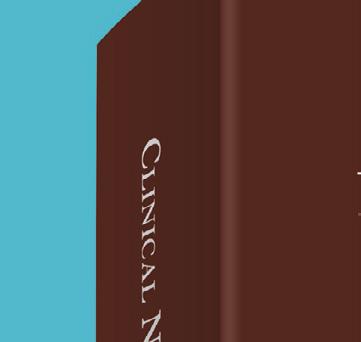
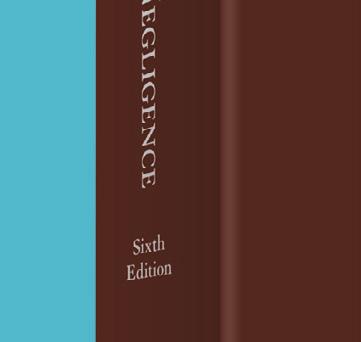
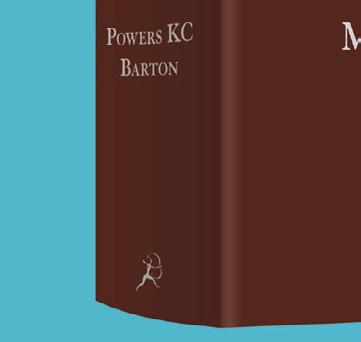
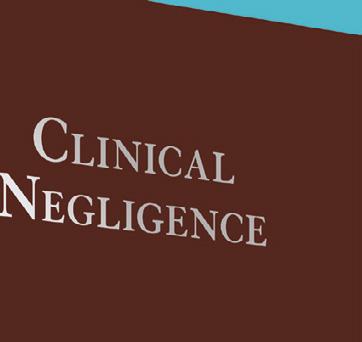
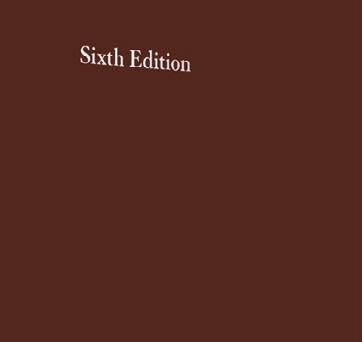
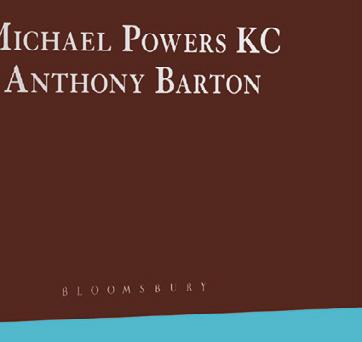
BOOK REVIEW
authors expertly guide those less versed in medicine confidently through the often complex medical issues.
Chapter 1, which discusses the issues with clinical negligence litigation, doesn’t shy away from considering a future where the current system is replaced, and this raises plenty of food for thought.
The chapters on gynaecology and obstetrics (written by Andrew Farkas, and Drs Ferriman and Levy, respectively) are an excellent introduction to these areas, which often give rise to high value claims. We are guided with deft hands through issues including gestational diabetes, venous thromboembolism, and the myriad issues which can affect mother and child, and steered as to what to look out for when dealing with claims arising out of obstetric or gynaecology issues.
Fundamentally, this book touches on all the issues likely to arise when dealing with clinical negligence litigation. It is an extremely useful and accessible resource for lawyers in this area at any level. After all, we never stop learning.


Sixth Edition

Foreword by Mr Justice Poole



MICHAEL POWERS KC & ANTHONY




Written by a team of more than 60 experts, Clinical Negligence remains the only text of its kind to cover both the medical and legal aspects of medical negligence. Fully revised and restructured, it includes new chapters on the future of clinical negligence litigation, cardiology, gynaecology, obstetrics, and haematology, with analysis of recent key cases. 2023 | 1,608 pages | 9781526521521 | HB | £575 £460











LEGAL MEDICO MAGAZINE Sponsored by:
CLINICAL NEGLIGENCE
Explore the new edition at www.bloomsburyprofessional.com 20% off for Medico-Legal magazine readers! Use promotion code CN-MEDLEGAL20 when ordering at www.bloomsburyprofessional.com. Discount valid on HB and e-book editions until 01 July 2024. “
their
tall
them.” Tim
previous edition) OUT6THEDITION NOW!
ere are certain law books that stand out as in a class of
own and … Clinical Negligence stands
among
Kevan, PIBULJ.COM (of the


EXPERT WITNESS DIRECTORY

LEGAL MEDICO MAGAZINE
Andrew Chukwuemeka
MB BS MD FRCS (Eng) FRCS (CTH) LLB (Hons)
Consultant
Cardiothoracic Surgeon
t: +44 (0)208 383 2026
e: andrew.chukwuemeka@nhs.net

Acting for Claimants, Defendants and as a single joint expert, a Consultant Cardiothoracic Surgeon with Imperial College Healthcare NHS Trust, he is Medical Director at Hammersmith Hospital and was previously Clinical Director for Cardiac Sciences (Cardiology, Cardiothoracic and Vascular Surgery). His clinical interests include Chest Trauma, Aortic Surgery including Transcatheter Aortic Valve Implantation (TAVI), Heart Valve and Coronary Artery Bypass Surgery.
Mr Chukwuemeka was the Royal College of Surgeons’ Regional Specialty Advisor and served on the Medical Technologies Committee at NICE. He serves on the NHSE - Clinical Reference Group for Cardiac Services, NHSE - London Clinical Senate Council and the Medicines and Healthcare products Regulatory Agency (MHRA).
 Dr David Newby BSc MBChB FRCA LLM
Dr David Newby BSc MBChB FRCA LLM
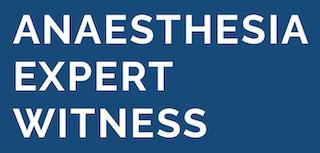
Consultant Paediatric and Adult Anaesthetist
t: +44 (0)7428467803
e: ddp.medicolegal@gmail.com

w: www.anaesthesiamedicalexpert.co.uk
Dr David Newby is a substantive anaesthetic consultant at Ipswich Hospital. He is the lead anaesthestist for paediatric services and established and runs the consultant-led paediatric preoperative assessment clinic. His adult work
includes orthopaedic trauma and vascular surgery.
Areas of particular expertise:
• anaesthesia for children in the district general hospital
• paediatric preoperative assessment
• TIVA in children
In addition to:
• all aspects of adult perioperative care, including preoperative assessment
• high-risk surgery awareness under anaesthesia
• anaphylaxis
• shared-decision making
David Simon Costain Gait & Posture Centre
Podiatric Consultant and Gait Specialist
t: +44 (0)207 636 4465
e: clinic@gaitandposture.com w: www.gaitandposture.com

David Simon Costain is a Podiatric Consultant and Gait Specialist, based in Harley Street, London. He has over 45 years of experience in Podiatry and is the CEO of the Gait & Posture Centre.
He specialises in the analysis of gait related musculo-skeletal problems relating to foot and leg malfunction, dividing his time between his private practice and expert witness work. He focuses on Personal Injury cases where approximately 75% of his work is for the claimant, and 25% for the defendant.


Professor Panayiotis (Panos) Kyzas

Consultant OMFS H&N Surgeon
t: +44 (0)750 5402 640
e: kyzasp@icloud.com
e: Panayiotis.Kyzas@elht.nhs.uk
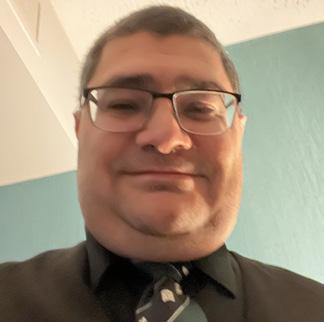

My name is Professor Panayiotis (Panos) Kyzas. I am a consultant in OMFS/Head and Neck Surgery with a clinical specialty interest in ablation and reconstruction of head and neck cancer and facial skin cancer. I am the Regional Specialty
Advisor (RSPA) for OMFS. I am the deputy editor of the main UK scientific journal for my specialty, and I am elected to become Editor-in-Chief in 2024, for 5 years. I am the chair for the OMFS Specialty Training Committee and the regional research advisor. I am the national OMFS representative on the TIG H&N fellowship committee and the Quality Assurance Lead. I have recently graduated my law degree with honours. I currently hold a Bronze National Clinical Excellence Award for my services to the NHS. I am the Chief Investigator of the MANTRA trial, a with multimillion pounds NIHR funding.
In August 2023 I have been appointed as a visiting Professor in OMFS H&N Surgery at Edge Hill University.

LEGAL MEDICO MAGAZINE EXPERT WITNESS DIRECTORY
EMAIL ME
EMAIL ME
EMAIL ME
EMAIL ME
Atul Khanna

Consultant Plastic, Reconstructive and Hand Surgeon
t: +44 (0)7360 750011
e: mrkplastics2021@gmail.com
w: www.atulkhanna.co.uk/expert-witness

Mr Khanna is a substantive NHS Consultant in Plastic, Reconstructive and Hand Surgery at The Sandwell and West Birmingham NHS Trust and has been involved in medical legal work since 1998. In this period he has provided over 3800 medical reports. He has prepared a chapter for the Encyclopedia of Forensic & Legal Medicine entitled "Medical malpractice in Cosmetic and Plastic Surgery".
Areas of expertise:
• Hand surgery: Sequelae of hand injuries and surgery
• Soft tissue injury:
• Burns management: Sequelae of disability following burns injury, scarring and surgery
• Medical negligence in Cosmetic Surgery
Dr Ana Phelps MD, PhD, FRCP, RCPathME
Substantive
Consultant Geriatrician
t: +44 (0)79706 27996
e: ana.phelps@nhs.net


Dr Phelps is a substantive Consultant Geriatrician at Buckighamshire Healthcare NHS Trust. She is a Medical Examiner, regularly reviewing hospital mortality cases and advising doctors on medical certification of cause of death and when to refer to a Coroner. Her expertise include Orthogeriatrics, Frailty, Dementia, Perioperative Medicine and complex cases in patients >65y.
Her medico-legal practice includes medical negligence, second opinions, decisions on escalation and resuscitation, ethical situations, inappropriate/harmful testing and treatments, and breeches in communication. She is able to provide comprehensive case reviews and expert opinion on the quality of the care provided at the different stages of care.

Philip McCann
Consultant Orthopaedic and Trauma Surgeon
t: +44 (0)117 933 9985
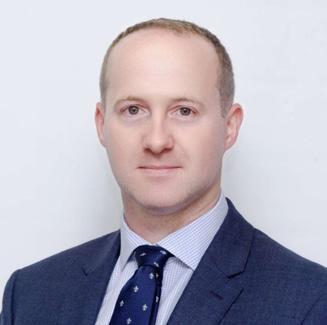
e: philmccann.secretary@soc-bristol.co.uk
w: www.shouldersurgeonbristol.co.uk
Mr McCann is a full time Trauma and Orthopaedic surgeon at University Hospitals Bristol and Southmead Hospital Bristol. He has a Specialist interest in:
• Fractures of the clavicle, shoulder, humerus and elbow
Arthroscopic (keyhole) surgery for shoulder problems including tendon tears, impingement, stiffness, instability and arthritis
• Primary and Revision Shoulder replacement surgery
• Management of post traumatic, degenerative and sports-related
• conditions of the upper limb
With his modern tertiary referral practice and extensive research portfolio, Mr McCann is able to provide comprehensive medicolegal reports (full reports and desktop screening reports) for both personal injury and clinical negligence cases.

Mr Sarwat
Sadek
MBBCh FRCSI FRCS (ORL-HNS) FRCS
Consultant Otolaryngologist and Head & Nech Surgeon
t: +44 (0)7802 974000
e: sarwatsadek@doctors.org.uk

Mr Sarwat Sadek has been practising as an ENT Consultant for nearly 40 years and is currently Consultant Otolaryngologist and Head & Neck Surgeon at Musgrove Park Hospital and the Nuffield Hospital, Taunton.
Areas of interest:
Noise induced hearing loss
• Occupational rhinitis
• Facial & neck trauma
• Traumatic loss of sense of smell and taste
• Deafness, tinnitus and vertigo as a result of road traffic accidents

LEGAL MEDICO MAGAZINE
EMAIL ME
EMAIL ME
EXPERT WITNESS DIRECTORY
EMAIL ME
VISIT WESBITE
Mr Aruni Sen
MS, FRCS, FRCEM, DipMedEd.
Lead Consultant in Emergency Medicine, Princess Elizabeth Hospital, Guernsey
t: +44 (0) 7839 755001
e: thesens@msn.com
Medico Legal Expert since 1996

Experience as independent expert for claimant, defence & SJE.
Areas of interest:
• Clinical Negligence
• Personal Injury
• Hand Injury
• Resuscitation
Trauma, Burns, Sedation & Acute Pain
• Musculoskeletal injuries
• CPR Part35 trained
• MEDCO accredited
• Up to date medico-legal CPD portfolio
• Reports vetted by solicitors
• Consultation Venues at: Chester (Cheshire, Northwest & North Wales), Guernsey & Jersey
Happy to provide pro-bono opinion
Member of EWI, APIL, Law Society.
Mr Shyam Kumar

Mr Nikhil Shah
FRCS(Tr & Orth) FRCS MCh(Orth) MS(Orth) DNB(Orth) MBBS
Consultant Trauma & Orthopaedic Surgeon
t: +44 (0)161 393 3059
e: nikhil.shah@consultantcare.com

Mr Nikhil Shah can act as an expert witness in personal injury and clinical negligence cases, taking instructions from either claimant or defendant or as a Single Joint Expert. He can provide medico legal reports for personal injury claims involving:
• Trips and slips
• Pelvic and acetabular fractures
• Low velocity impact cases
• Whiplash
• Long bone and articular fractures Ankle, knee and hip fractures, lower limb injuries
• Soft tissue injuries
Mr Shah can provide clinical negligence related reports in his specialist areas of expertise concerning:
• Primary and revision hip and knee replacements
• Pelvic and acetabular fractures
• Long bone and periarticular trauma


t: +44 (0)7596852737
w: www.medicolegalorthopaedics.com
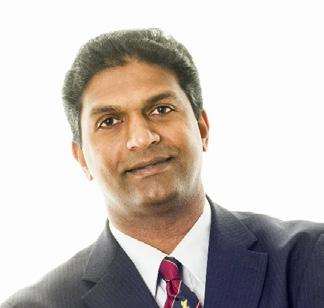
Mr Kumar, is a Consultant Orthopaedic Surgeon, specialising in trauma and upper limb conditions, with a focus on medicolegal practice since 2011. He serves on the trauma rota at the Royal Lancaster Infirmary. He holds an LLM in Medical Law & Ethics and is on the Medicolegal Committee of the British Orthopaedic Association. He performs assessment of doctors for the General Medical
Consultant Orthopaedic Surgeon Council and examines for the Royal College of Surgeons. With regulatory experience, he has advised the CQC. He provides concise medical reports for clinical negligence and personal injury cases, with clinics in Manchester, Lytham, Bolton and Lancaster.


• UK’s
• Reach over 90,000
•
and
LEGAL MEDICO MAGAZINE
EMAIL ME
EMAIL ME
EXPERT WITNESS DIRECTORY
EMAIL ME
BE FEATURED IN OUR DIRECTORY OF EXPERT WITNESSES www.medicolegalmagazine.co.uk
leading Medico-Legal Magazine
readers
Printed
digital ENQUIRE LEGAL MEDICO MAGAZINE
MEDICO -LEGAL NEWS:
By Lisa Cheyne, Medico-Legal Manager, SpecialistInfo
A round-up of news in the industry of the Second quarter of 2024

APIL calls for Compensation for all Victims of Dog Attacks
Since the covid lockdowns, there has been an increase in dog ownership, and an alarming rise in the number of people injured or killed in dog attacks in England and Wales.
Unfortunately, many people badly injured in dog attacks are not eligible to claim compensation from the Government Criminal Injuries Compensation Scheme (CICS), which pays damages to victims of violent crime, who suffer physical or mental health injuries.
The current CICS rules state animal attacks do not fall within the definition of a crime of violence, unless the owner intentionally uses or causes the animal to attack an individual.
However, it is a criminal offence to have a dangerously out-of-control dog anywhere, including in a public place or in the owner’s home. A criminal court can impose unlimited fines or prison sentences on dog owners who break the law.
The Government has recently added the American XL bully to the list of dogs banned in England and Wales under the Dangerous Dogs Act 1991.
APIL has told the Government that the scheme also needs updating, so that victims of all criminal dog attacks are eligible for compensation.
Read more: https://www.apil.org.uk/blog/Time-totreat-all-victims-of-dog-attacks-with-compassion

29 LEGAL MEDICO MAGAZINE Sponsored by:
NEWS
NEWS

Medico-legal Agency Fee Disclosure Rule
Claimant costs could be significantly reduced unless they reveal details of fees paid to the medico-legal agency handling their report.
In Parsons v Stevens, an RTA claim which had settled for £25,000, Deputy District Judge Fentem concluded that ordering a reply to the Part 18 request for a breakdown of costs from the defendant was ‘reasonably necessary and proportionate’ and that commercial sensitivity was not a good enough reason to refuse.
Claimant lawyers had wanted to recover the £5,880 (plus VAT) cost of a pain management report fee, but without a breakdown of what was paid to the agency, Premex. The judge reduced this to £1,250 for the doctor’s fee and £250 for the agency’s costs after the breakdown was not disclosed.
County courts in different parts of the country have reached different verdicts in similar cases, with calls growing for guidance from a higher court or the Civil Procedure Rule Committee.
Read more: www.lawgazette.co.uk/ download?ac=117050
Faculty of Expert Witnesses FAQs – Claimant Surveillance
Mr E. Witness completed a report for a law firm representing the defendant in an RTA and was subsequently sent surveillance tapes of the claimant by the law firm and was asked to review these and comment.
Would he first need a court direction/instruction to review any surveillance tapes?
Should he also request that the solicitors tell him the specific issues they want dealt with regarding the footage?
Jonathan Dingle, Barrister, Mediator and Lead Expert Witness Trainer at SpecialistInfo replies:
An expert may be instructed to consider surveillance. This may be directly from the original solicitors/ agency pre-litigation or sometimes after the claim has been issued, or it could be following a court order which should be provided to the expert. In both cases it is proper to prepare an addendum report.
When this happens, first they should consider how long it is likely to take to prepare an opinion and report and give a quote for cost and an estimate of when they can deliver the report – if there is any difficulty complying with any court order they should immediately say so. If the matter is requested by a solicitor or agency then they should await acceptance of their fee quote. If there is a court order, then they should comply and render a fee note.
When they consider the video, they should consider first whether the subject is definitely the Claimant. If there is any doubt they should say that their opinion is based on the presumption that the subject is Claimant but obviously if that is incorrect then the materials are of no value.
Then they should consider from the perspective of their own area of expertise only what if anything the video can assist them with: the expert should not speculate about matters outside their own area of expertise.

30 LEGAL MEDICO MAGAZINE Sponsored by: NEWS
Sometimes video surveillance is thought by experts to be of no value at all; sometimes it is thought to be important. Where it raises questions about what the expert has recorded they were previously told about the ability of a person to do certain things then the expert can of course highlight the disparity but in every case they should also indicate (a) how and of at all it changes their opinion on any issue and (b) whether there would be a range of reasonable opinion on the issue as between experts of the same discipline.
Finally, they should prepare the report under the usual declaration and addressed to the court in the usual way, and then send it to the person who originally instructed them with a fee note requesting conformation of receipt.
For upcoming expert witness training dates with Jonathan Dingle and colleagues from Normanton Chambers see: https://www.specialistinfo.com/course-calendar-2024
SEE TRAINING DATES
Report by The All-Party Parliamentary Group on Birth Trauma
Published
The All-Party Parliamentary Group (APPG) on Birth Trauma report was published this May, and has suggested several major recommendations, including:
• Recruit, train and retain more midwives, obstetricians and anaesthetists to ensure safe levels of staffing
• Roll out and implement, the OASI (obstetric and anal sphincter injury) care bundle to all hospital trusts to reduce risk of injuries in childbirth
• Respect mothers' choices around giving birth and access to pain relief
• Commitment to tackling inequalities in maternity care for ethnic minorities, particularly black and Asian women
• Universal access to specialist maternal mental health services to end the postcode lottery across the UK
A new maternity commissioner, who would report directly to the prime minister, is a key recommendation in the inquiry's report, along with ensuring safe levels of staffing.
NHS Resolution has announced a collaboration with THIS Institute (The Healthcare Improvement Studies Institute) at the University of Cambridge to support the evaluation of its two maternity safety programmes: the Early Notification Scheme and Maternity Incentive Scheme.
The dissolution of parliament took place on Thursday 30 May 2024, until after the general election on 4th July 2024.
Other all- party parliamentary meetings were due to take place in May on historic and ongoing harms in women involving mesh, and drugs Valproate and Primodos, which can cause birth defects. Ongoing APPGs campaigns will now be paused until after the GE.
Read more : https://www.theo-clarke.org.uk/birth-trauma

31 LEGAL MEDICO MAGAZINE Sponsored by: NEWS
BMA Announces Junior Doctors Strike in June/July and Possible GP Collective Action in August
In May, following the Government’s refusal to meet their demands for a roadmap to restore pay lost over the last 15 years in England, junior doctors announced new strike dates, just before the general election, involving a full walkout beginning at 7am 27th June and ending 7am 2nd July 2024.
This follows a BMA referendum in March asking GP members whether they accepted the changes to the 2024/25 contract. More than 19,000 GPs took part and almost 100% voted ‘no’. The Government has so far failed to make any changes to the contract, prompting the committee to launch a ballot on collective action.
The ballot is open to all GP contractors/partners from Monday 17 June and closes on Monday 29 July ahead of action commencing from Thursday 1 August, depending on the result.
Read more: https://www.bma.org.uk/our-campaigns
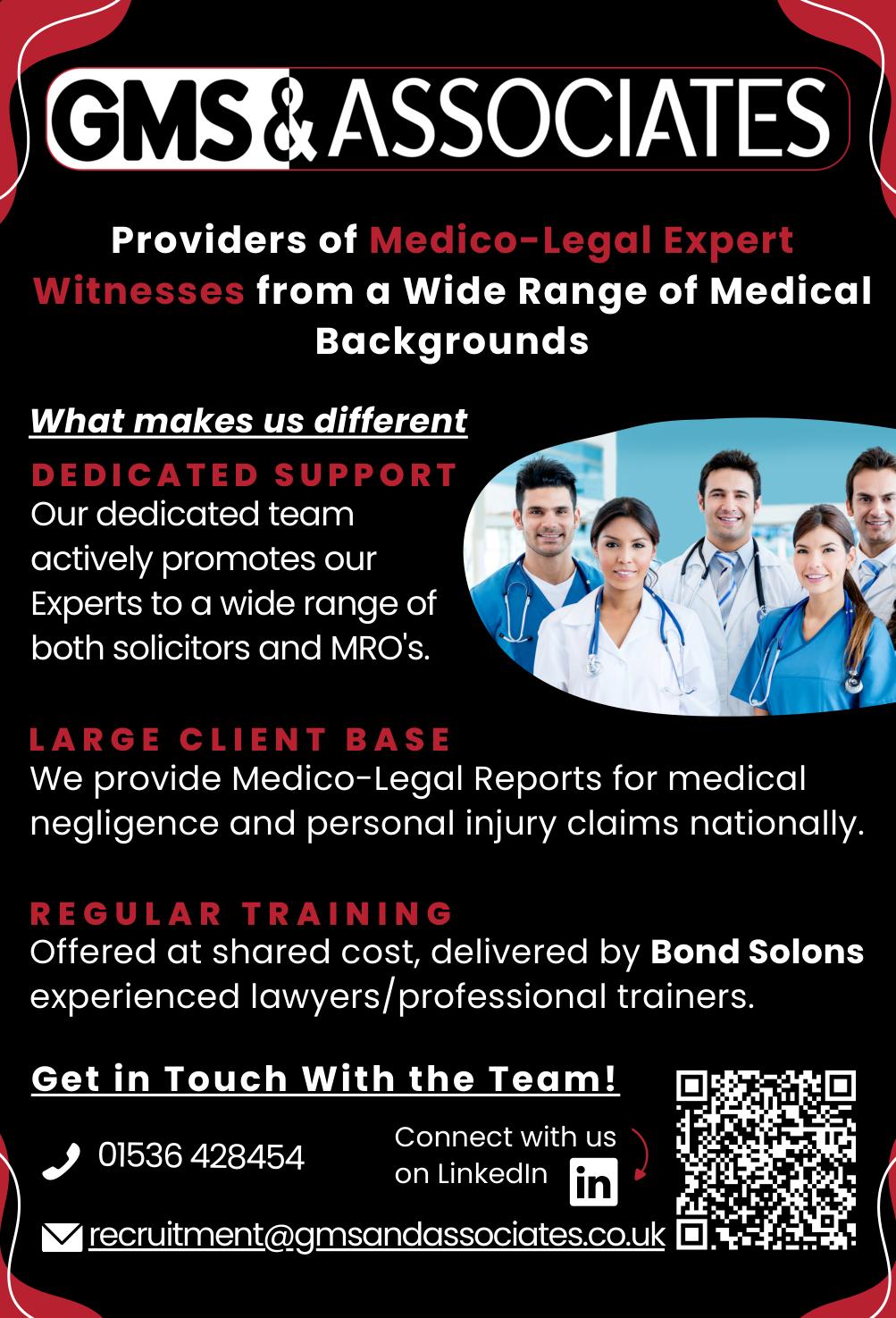


Early-Bird Medical AI, Robotics & Technology Conference 2025
Bookings are Open!
Now in its third year, the SpecialistInfo Medical Al, Robotics & Technology Conference brings together healthcare leaders, doctors, practitioners, tech innovators, and experts who are at the forefront of a changing healthcare system, who wish to enhance their knowledge in this fast-developing field, and showcase new technology in the world of healthcare. It will feature talks by some of the industry's most knowledgeable speakers with first-hand experience of developing and implementing these techniques and devices.
Confirmed 2025 Speakers include:
• Mark Slack, CMR Surgical
• Mark Wilson, Founder of the GoodSAM app
• Omer Karim, Intuitive, Consultant Urologist
• Amrita Kumar, Consultant Radiologist – named 2022 Top 50 Innovator & Top - 50 Influential Woman in the UK for leading innovation in the use of AI within the NHS
Congress Centre, London, 4th March 2025



32 LEGAL MEDICO MAGAZINE Sponsored by: NEWS
more and book:
BOOK PASS
Read
www.medical-ai-and-robotics.com

Supreme Court Backs
Claimants in Hybrid Injury Test
Case Hassam and Another v Rabot and Another [2024] UKSC 11
Personal injury lawyers have won the right to claim extra damages for claimants’ non-whiplash injuries, despite Insurers submitting that separate compensation for the other injury should only be added if the claimant could establish it was different to the pain, suffering and loss of amenity (PSLA) covered by the whiplash injury.
The Supreme Court dismissed insurers’ appeals in the joint cases of Hassam and another v Rabot and another in a long-running dispute over so-called hybrid claims.
The decision means that litigants using the Official Injury Claim portal for low-value RTA claims can be compensated for bodily injuries as well as for soft tissue injury, although the court must still decide if deductions should be made to avoid double payments for the same consequences.
Lord Burrows, giving the lead judgment, said at the outset that while the sums involved were small, thousands of cases were potentially affected by this decision.
This judgment of the Supreme Court concerned Part 1 of the Civil Liability Act 2018 and the Whiplash Injury Regulations 2021 (SI 2021/642).
The act sets a statutory tariff for whiplash-type injuries, but many claimants suffer other types of injury in addition. A court dealing with multiple types of injury would consider the various injuries and fix a particular figure as reasonable for each. It would then consider whether the award for PSLA should be greater to reflect the combined effect of all the injuries upon the injured
person’s recovering quality of life, or smaller in order to remove an element of double recovery.
The problem for the Supreme Court was the approach to be used where the injuries included a fixed tariff whiplash and other types of injury, which were subject to a common law assessment.
In the first test case, for example, the claimant suffered whiplash injuries to his neck and back. He also suffered non-whiplash soft tissue injuries to his knees. At an assessment hearing, the tariff amount for the whiplash injuries was assessed at £1,390 and the common law damages for PSLA for the knee injuries at £2,500, resulting in an overall figure of £3,890. The court then reached a final figure, by making an appropriate deduction and identified a ‘clear overlap’ between the PSLA from the different types of injury. The overall award was therefore assessed down to £3,100.
Read more : https://www.supremecourt.uk/cases/ uksc-2023-0025.html
GMC Consultation on Regulation of MAPs Closed on 20 May
The GMC has closed its public consultation on its rules, standards, and guidance for physician associates (PAs) and anaesthesia associates (AAs), collectively known as Medical Associated Professionals (MAPs). MAPs are currently working in the NHS in a variety of roles across primary and secondary care. They complete a two-year postgraduate course (1,600 hours of clinical experience and teaching) but are increasingly being employed in the NHS in roles that had previously been reserved for doctors, and in many cases as direct substitutions for doctors, working on doctors’ rotas. They do not have a medical degree and must always be supervised by a doctor.
The consultation addresses concern that registration with the GMC blurs boundaries with doctors, and that the GMC is not an appropriate choice for regulator of PAs and AAs. The BMA opposes regulation by the GMC and states the Health and Care Professions Council is more appropriate.
Read more: https://bma.org.uk/media/wjnmmbsu/ bma-gmc-maps-consultation.pdf

33 LEGAL MEDICO MAGAZINE Sponsored by: NEWS
Image Credit: Smuconlaw

Mandatory MOJ Mediation Scheme in Civil Cases
The Ministry of Justice is piloting a new requirement to mediate in low-value money claims from this May. MoJ head of dispute resolution policy, Kim Wager, pointed to the success of a Canadian mandatory mediation model.
‘We haven’t ruled out mandatory referral to mediation for higher value claims in the county courts, so those over £10,000. It seems to work well in Ontario in Canada; they have had it in place for over 20 years now [for] all cases that go to the court… including personal injury… That remains of interest as a potential model to develop a mandatory mediation arrangement in England and Wales.’
Money claims worth under £10,000 filed on or after 22 May, will include a requirement for parties to attend a free, one-hour telephone mediation arranged through the small claims mediation service (SCMS) before the claim can then proceed to court if no settlement is reached.
The number of claims dealt with by the SCMS is expected to grow from 20,000 annually under the current voluntary service to 92,000 per year, with 39 new mediators already recruited.
Wager said: ‘We conc luded that the only way to move the dial on this and drive take up would be to require it; to make mediation an integrated step in the resolution journey, which includes penalties for noncompliance.’
‘The impact assess ment tha t we published modelled a 15 - 55% settlement rate… and we estimate this would free up between 1,400 and 5,200 sitting days; between 9% and 32% of all county court sitting
days. So, it would release a significant amount of resource for those cases that do need to go before a judge.’
Wager said the MoJ welcomed the Court of Appeal's ruling in Churchill v Merthyr Tydfil Council last November that a court can lawfully stay proceedings and order parties to engage in noncourt dispute resolution.
‘This is an area that requires extensive further consideration to strike the right balance in the public interest.’
More recently in the decision HHJ Mithani KC in Conway v Conway & Anor (Rev1) [2024] EW Misc 19 (CC) at the end of May, costs were reduced following refusal to mediate.
The defendant’s costs in this case were reduced by 25% because they rejected the claimant’s offer of mediation, despite having a strong case and ultimately succeeding. The judge found that mediation would probably not have succeeded; however, to reject an offer of mediation out of hand was unreasonable conduct.
Read more : https://www.lawgazette.co.uk/ news/moj-moves-the-dial-on-mandatorymediation/5119687.article
https://www.bailii.org/cgi-bin/format.cgi?doc=/ ew/ cases/Misc/2024/19.html&query=(Mithani)stand
Infected Blood Final Report 20 May
Following publication of the final report on the infected blood scandal by Sir Brian Langstaff in May, the Government has announced further details of compensation arrangements for those infected and/ or affected by contaminated blood.
At the time of going to press, this includes details of the expanded groups that will be eligible for compensation and a commitment that further interim payments of £210,000 will be paid within 90 days to living infected beneficiaries ahead of the establishment of the final scheme.
Read more: https://www.infectedbloodinquiry.org.uk/ reports/inquiry-report


34 LEGAL MEDICO MAGAZINE Sponsored by: NEWS
Advocating









35 LEGAL MEDICO MAGAZINE Sponsored by: JOURNAL MEDIATION U K @UKMediationJournal @UKMediationJ
Mediation in Business
in
year, the UK Mediation Journal is the UK’s leading mediation publication, advocating the benefits of mediation in business. There is still an overwhelming need for effective conflict management solutions in the workplace and our publication is designed to equip business leaders and HR professionals with the skills and resources needed. www.ukmj.co.uk VIEW PAST ISSUES SUBSCRIBE
@UKMediationJournal @UKMediationJ
Mediation in Business
in
sixth year,
UK Mediation Journal is the UK’s leading mediation publication, advocating the benefits of mediation in business. There is still an overwhelming need for effective conflict management solutions in the workplace and our publication is designed to equip business leaders and HR professionals with the skills and resources needed. www.ukmj.co.uk VIEW PAST ISSUES SUBSCRIBE PUBLISHED BY
Now
our sixth
JOURNAL MEDIATION U K
Advocating
Now
our
the

WHAT’S IN IT FOR OUR EXPERTS? INTERESTED IN JOINING THE LARGEST EXPERT PANEL IN THE MEDICO-LEGAL INDUSTRY? INTERESTED IN LEARNING MORE? Contact our team by phone or email. Email: ExpertRecruitment@premex.com Telephone: 01204 478300 Favourable payment terms Flexibility of workload Free use of advanced technology Annual CPD-accredited conference Opportunities to work with industryleading personal injury and clinical negligence firms In-house support from our dedicated Expert Liaison team As the UK’s leading provider of medico-legal reports, Premex prides itself on hand-selecting the best medical experts in the industry to deliver the highest quality service to our customers.





























































 Dr David Newby BSc MBChB FRCA LLM
Dr David Newby BSc MBChB FRCA LLM





































